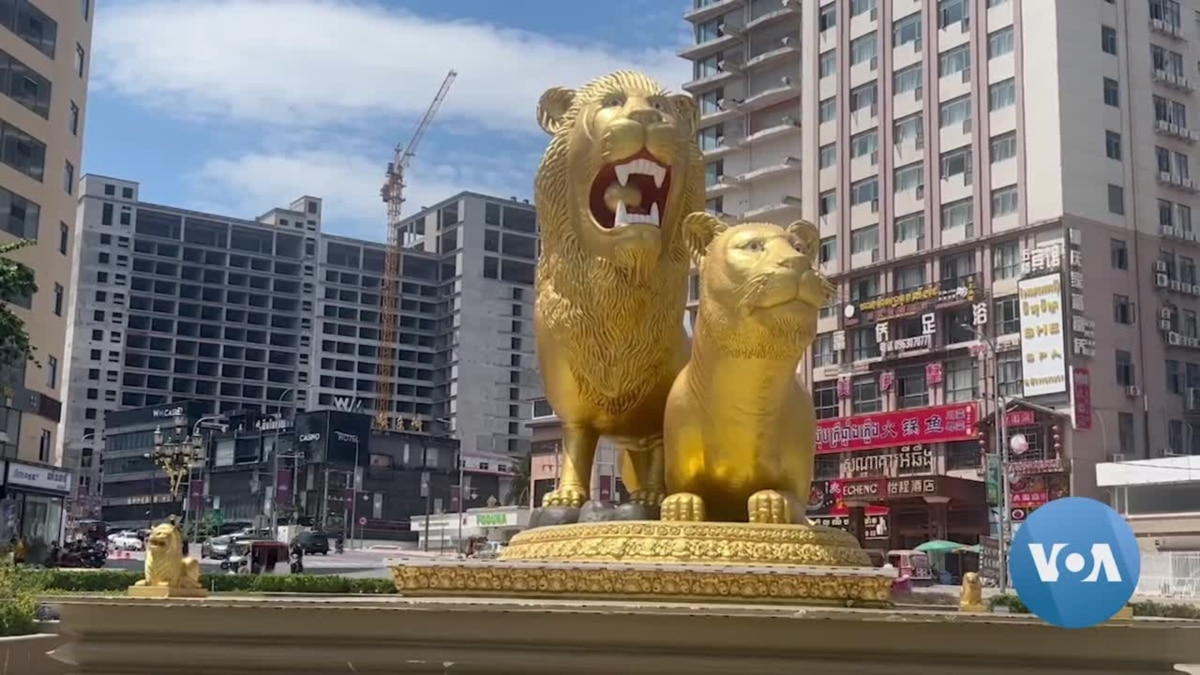
PHNOM PENH, CAMBODIA —
Five years ago, Chinese investors began turning Sihanoukville, a sleepy coastal city with pristine beaches, into a gambling mecca rivaling Macao and Las Vegas, but that ended with a ban on online gambling and the COVID-19 pandemic.
More than 200,000 Chinese workers had to return home.
Casinos closed and partially built skyscrapers, resorts and condominium projects were left abandoned. One pro-government media outlet described the remaining skyline as “a stark reminder of botched investments, mostly by Chinese nationals.”
Housing has slumped by as much as 90% in recent years according to the Cambodian Ministry of Economy and Finance.
Chantha Lach, like many small private investors, told VOA he was hoping for better times and foreign investment.
“Many Cambodians want the Chinese investor to return because the property prices are dreadful, and we want the Chinese businesspeople to return to help the market to recover,” he said.
In response, Cambodia is drawing up an action plan to clean up more than 1,100 incomplete buildings in Sihanoukville. Suggestions include tripling the local population to 1 million with visa-friendly regimes for foreigners and tax breaks for Cambodia’s expanding middle class.
Authorities are also considering a 2026 deadline for developers, ordering them to either tear down or complete buildings still under construction.
“One of the biggest challenges is to ensure that these half-completed projects, which are dotted around Sihanoukville city, are ready for construction,” said David Totten, managing director of the investment company Emerging Markets Consulting in Phnom Penh.
“So there needs to be a process of validating that. In some cases that might involve removing the existing construction, starting over from scratch,” he said.
Totten also said about 50% of the incomplete buildings left suspended or abandoned have created legal issues regarding ownership and responsibilities.
“A large proportion of those, ownership may be in doubt, legal entities that are the beneficial owners of those projects may no longer exist or be relatively inactive,” he said. “There will be a lot of challenges therefore in claiming those properties from previous owners.”
Investors are trickling back
A substantial Chinese-funded upgrade of the controversial Ream Naval base, about 30 kilometers east of Sihanoukville, is also under way. The United States is concerned the base could extend China’s military presence in Southeast Asia, where Beijing is increasingly assertive over its contested claims to the South China Sea.
Washington said Ream will be China’s second foreign naval base, after Djibouti.
However, Beijing and Phnom Penh have dismissed those concerns, saying it is not a Chinese base. Cambodia said the base’s facilities will be open for many nations.
Not far from Ream, construction of a new tourist development, known as the Bay of Lights, is being built on 934 hectares of land reclaimed from the sea by Canopy Sands Development, led by Chinese businessman Chen Zhi.
The project is expected to be completed by 2028. However, Harrison White, editor of the Cambodia Investment Review news outlet, said much more is planned for the area and further construction could last until 2040.
“The project’s going to be bringing a very large amount of investment, approximately $16 billion, could even be more,” he said.
“As the project goes along, we’re expecting [the] population to grow to 160,000, as well as 330,000 jobs, as well as many more, maybe even 3 million more tourists that are going to visit the region,” he added.
Cambodia wants economic growth to return to pre-pandemic levels, buoyed by Chinese investors and tourists, which, according to the Tourism Ministry topped 2.36 million visitors in 2019 and generated about $1.8 billion in revenue.
The ministry also said Chinese investment in tourism-related sectors accounted for more than 50% of total foreign direct investment and there has been speculation that Chinese people will be allowed to emigrate and work there.
Some projects, like the Chinese-funded $2.5 billion expressway linking Phnom Penh with Sihanoukville, have been finished. Another expressway will be built by China Road and Bridge Construction from the capital to the Vietnamese border.
There are multi-billion-dollar plans to link the Thai and Vietnamese borders and the south coast through a network of high-speed railways. Most will be built by Chinese investors and fit neatly within Beijing’s Belt and Road Initiative, which is reemerging in a post-pandemic world.
“Cambodia is very much in need of appealing to foreign buyers. The country itself, whilst [having a population of] only 17 million, is sitting in a region of billions, with China, Vietnam, Thailand, the Philippines and many more, are looking to enter the market,” White said.
“So, these sorts of projects are critical for Cambodia to ensure itself open to foreigners, and also to develop its economy,” he added.
The cost of these investments is raising eyebrows. On Friday, the minister of public works and transport, Sun Chanthol, said 150 infrastructure projects worth about $30 billion had been prioritized for 2022-2030. A tall order given Cambodia’s GDP was just $27 billion in 2019.
Sreynat Sarum contributed to this report.